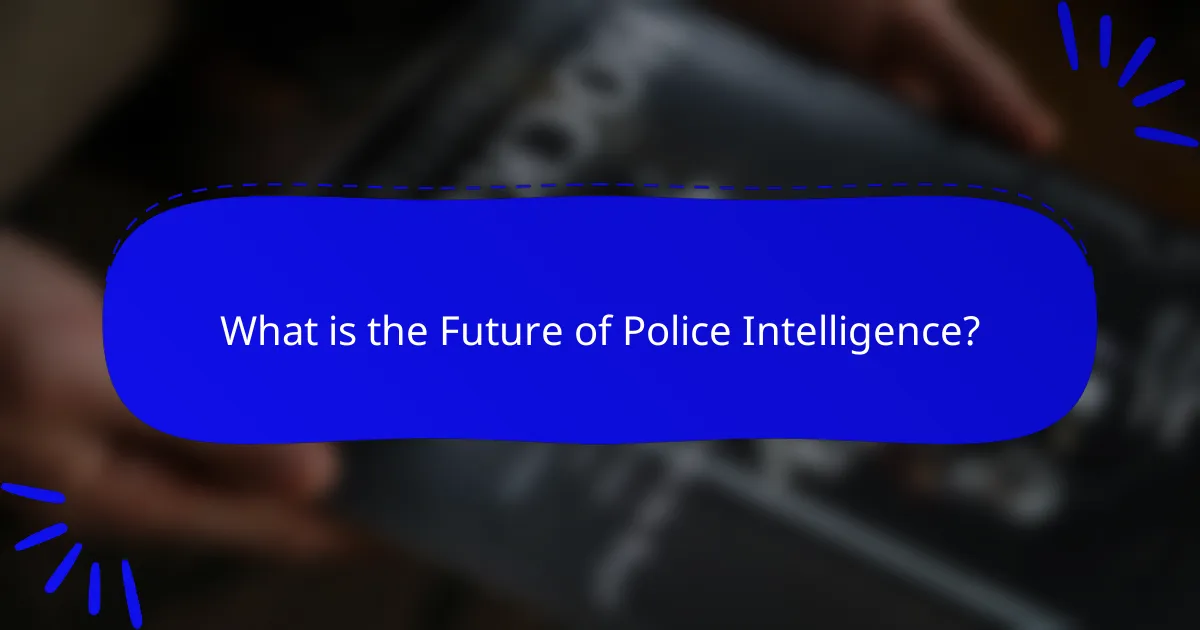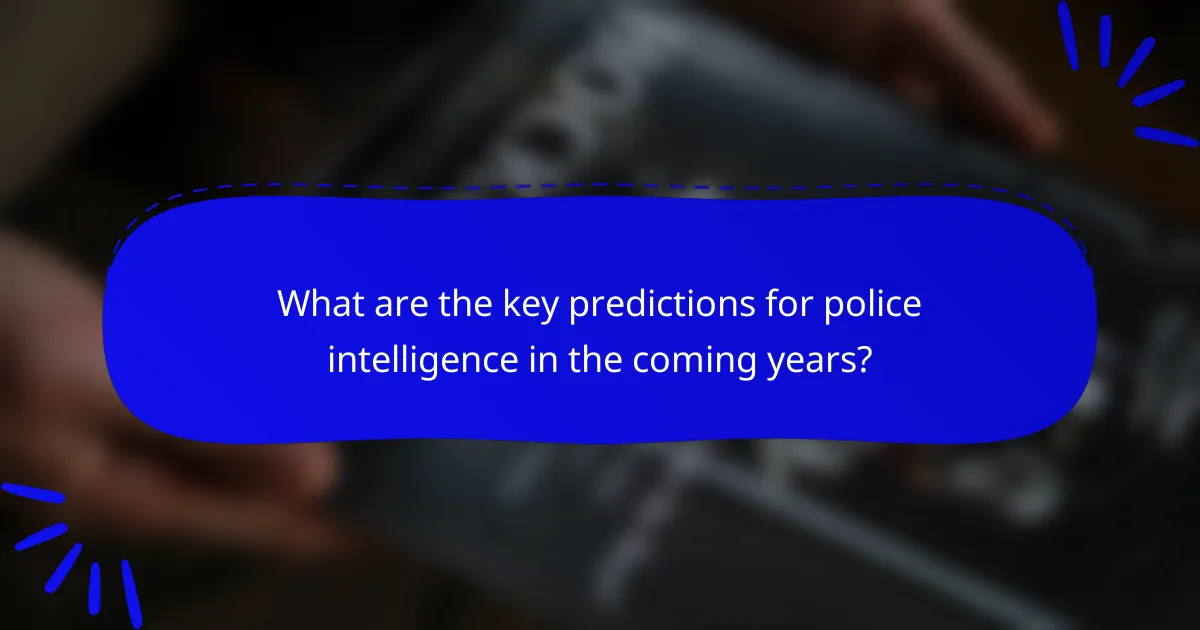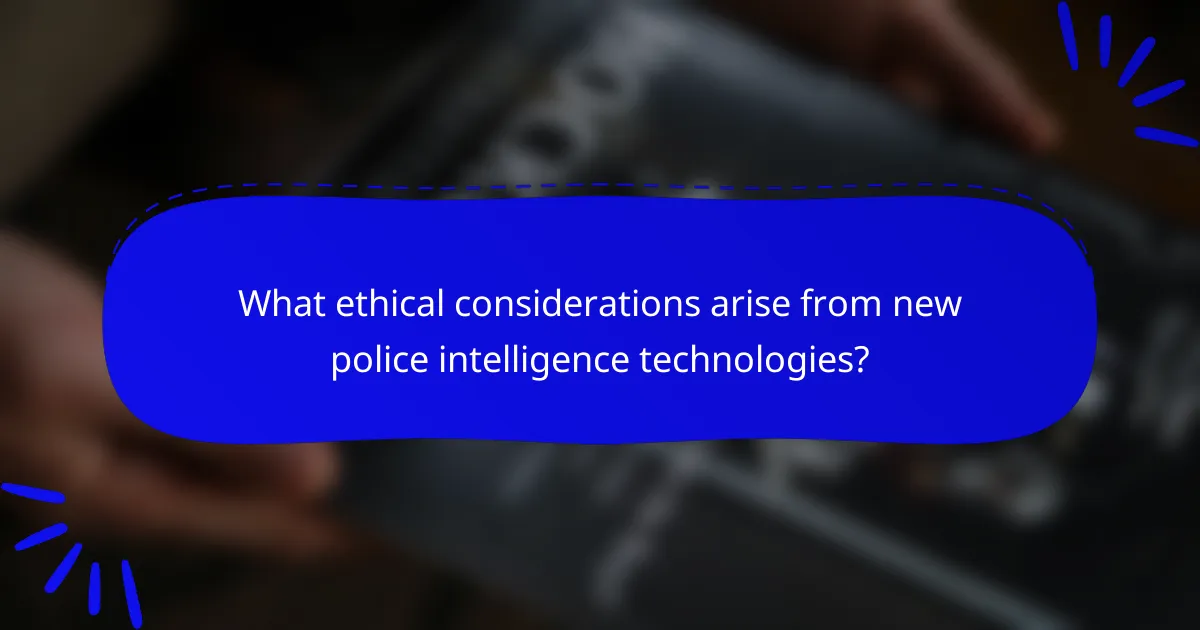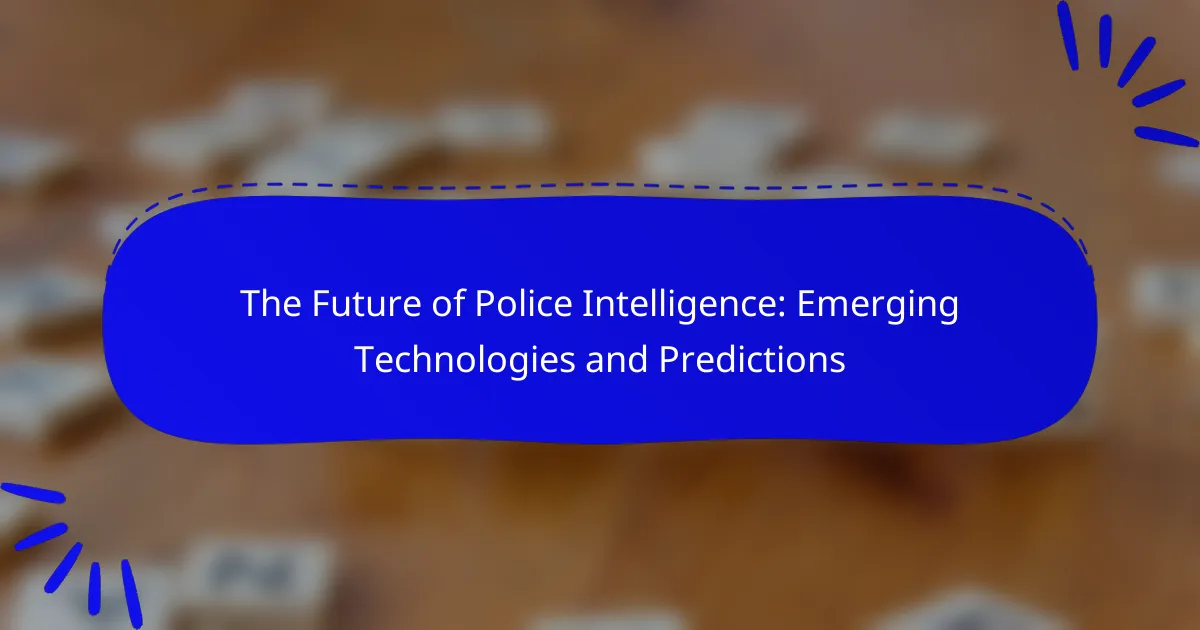
What is the Future of Police Intelligence?
The future of police intelligence will be heavily influenced by advancements in technology. Artificial intelligence is expected to enhance data analysis and predictive policing. Machine learning algorithms will improve the accuracy of crime forecasts. Additionally, integration of real-time data from various sources will provide actionable insights. Drones and surveillance technologies will aid in monitoring and response. Cybersecurity measures will become crucial as data collection increases. Collaboration with tech companies will drive innovation in policing methods. Overall, these trends suggest a more proactive and efficient approach to law enforcement.
How are emerging technologies shaping police intelligence?
Emerging technologies are significantly shaping police intelligence by enhancing data collection and analysis capabilities. Advanced analytics tools enable law enforcement to process vast amounts of data quickly. Artificial intelligence (AI) assists in identifying patterns and predicting criminal behavior. Machine learning algorithms improve the accuracy of threat assessments. Drones and surveillance technology provide real-time situational awareness during incidents. Geographic information systems (GIS) help in mapping crime hotspots effectively. According to a 2021 study by the Police Executive Research Forum, 75% of police departments reported using technology for crime analysis. This integration of technology leads to more informed decision-making and strategic resource allocation.
What specific technologies are being adopted in police intelligence?
Artificial intelligence, data analytics, and surveillance technologies are being adopted in police intelligence. AI is used for predictive policing, analyzing crime patterns. Data analytics helps in processing large volumes of information quickly. Surveillance technologies include drones and body cameras for real-time monitoring. [censured] recognition systems are also increasingly utilized for identifying suspects. Geographic information systems (GIS) aid in mapping crime hotspots. Mobile applications facilitate communication between officers and the community. These technologies enhance efficiency and effectiveness in law enforcement operations.
How do these technologies enhance data collection and analysis?
Emerging technologies enhance data collection and analysis by automating processes and increasing accuracy. They enable real-time data gathering from various sources, such as social media and surveillance systems. Advanced algorithms process large datasets quickly, identifying patterns and trends more efficiently than manual methods. Technologies like artificial intelligence and machine learning improve predictive analytics, allowing law enforcement to anticipate criminal activities. For instance, a study by the National Institute of Justice highlights that AI can reduce data processing time by up to 80%. These technologies also facilitate data visualization, making complex information easier to interpret for decision-makers. Overall, they transform raw data into actionable insights, improving police intelligence operations.
Why is the evolution of police intelligence important?
The evolution of police intelligence is important because it enhances law enforcement effectiveness. Improved intelligence allows for better crime prevention and response strategies. Historical data shows that agencies utilizing advanced intelligence techniques reduce crime rates significantly. For example, the adoption of data analytics in policing has led to a 30% decrease in property crimes in several cities. Additionally, evolving technology helps police agencies adapt to new criminal tactics. This adaptability is crucial for maintaining public safety in a changing environment. Overall, the evolution of police intelligence directly impacts community safety and resource allocation in law enforcement.
What challenges does traditional police intelligence face?
Traditional police intelligence faces several challenges. One significant challenge is the integration of disparate data sources. Many police departments operate with outdated systems that do not communicate effectively. This leads to gaps in information and delays in response times.
Another challenge is the reliance on human analysis, which can be subjective and error-prone. Studies indicate that human analysts may overlook critical patterns due to cognitive biases. Additionally, traditional methods often struggle to keep pace with rapidly evolving criminal tactics.
Privacy concerns also pose a challenge. The collection and analysis of data must balance public safety with individual rights. This often results in hesitance to adopt new technologies. Finally, limited resources and funding restrict the ability to invest in advanced analytical tools.
These challenges hinder the effectiveness of traditional police intelligence in addressing crime proactively.
How does improved police intelligence impact community safety?
Improved police intelligence enhances community safety by enabling more effective crime prevention and response. This intelligence allows law enforcement to identify crime patterns and hotspots. By analyzing data, police can allocate resources more efficiently. Enhanced intelligence leads to quicker response times to incidents. It also fosters better collaboration with community members. Trust between police and the community increases as transparency improves. Studies show that communities with strong police intelligence networks experience lower crime rates. For instance, cities that implemented predictive policing saw a reduction in property crime by up to 20% over several years.

What are the key predictions for police intelligence in the coming years?
Key predictions for police intelligence in the coming years include increased use of artificial intelligence and machine learning. These technologies will enhance data analysis capabilities. Predictive policing will become more prevalent, allowing law enforcement to anticipate criminal activity. Integration of real-time data from various sources will improve situational awareness. Enhanced surveillance technologies, including drones and [censured] recognition, will be widely adopted. Collaboration with private tech firms will drive innovation in policing methods. Cybersecurity measures will be prioritized as digital crimes increase. Overall, police intelligence will evolve towards a more data-driven and proactive approach.
How will artificial intelligence influence police operations?
Artificial intelligence will significantly influence police operations by enhancing data analysis and decision-making processes. AI systems can analyze large volumes of data quickly, identifying patterns and trends that human analysts may miss. For instance, predictive policing uses algorithms to forecast crime hotspots based on historical data. This approach has been adopted by various police departments, leading to more efficient resource allocation. Additionally, AI-powered tools can assist in real-time surveillance, improving situational awareness during incidents. Studies have shown that departments utilizing AI technologies report increased response times and reduced crime rates. These advancements indicate a transformative shift in how law enforcement agencies operate and respond to challenges.
What role does machine learning play in predictive policing?
Machine learning plays a critical role in predictive policing by analyzing vast amounts of data to identify patterns. It utilizes algorithms to predict where crimes are likely to occur. These predictions help law enforcement allocate resources more effectively. For instance, a study by the RAND Corporation found that machine learning can improve crime prediction accuracy by up to 20%. Machine learning models can process historical crime data, social media activity, and demographic information. This data-driven approach aims to enhance public safety and reduce crime rates. However, ethical considerations regarding bias and privacy remain significant challenges.
How can AI improve decision-making processes in law enforcement?
AI can improve decision-making processes in law enforcement by enhancing data analysis and predictive policing. It can analyze vast amounts of data quickly, identifying patterns that humans may overlook. For instance, AI algorithms can assess crime trends and hotspots, aiding resource allocation.
Additionally, AI can streamline communication within departments, ensuring timely sharing of critical information. A study by the RAND Corporation found that AI tools can reduce response times in emergency situations.
Moreover, AI can assist in risk assessment, helping officers make informed decisions about potential threats. By integrating AI, law enforcement can enhance efficiency and effectiveness in their operations.
What advancements in data analytics are expected?
Advancements in data analytics are expected to include enhanced predictive analytics, real-time data processing, and improved machine learning algorithms. Predictive analytics will allow law enforcement agencies to anticipate criminal activity more accurately. Real-time data processing will enable immediate responses to incidents as they occur. Improved machine learning algorithms will enhance the accuracy of data interpretation and decision-making processes. A report by McKinsey highlights that organizations leveraging advanced analytics can increase their productivity by 5-6%. These advancements will ultimately lead to more effective policing and resource allocation.
How will real-time data integration transform police responses?
Real-time data integration will significantly enhance police responses. It allows for immediate access to critical information during emergencies. Officers can receive live updates on incidents, including location data and suspect profiles. This quick access enables informed decision-making on the scene. Studies show that departments using real-time data have improved response times by up to 30%. Enhanced situational awareness reduces risks for officers and civilians alike. Additionally, integrated systems can analyze patterns in crime data, predicting potential hotspots. This proactive approach shifts policing from reactive to preventive measures. Overall, real-time data integration is a game-changer for law enforcement effectiveness.
What are the implications of big data for crime prevention strategies?
Big data has significant implications for crime prevention strategies. It enables law enforcement agencies to analyze vast amounts of information quickly. This analysis helps identify crime patterns and trends. Predictive policing models utilize algorithms to forecast potential criminal activity. Such models can improve resource allocation and response times. For instance, the Los Angeles Police Department uses data analytics to anticipate crime hotspots. Studies show that data-driven approaches can reduce crime rates by up to 30%. Furthermore, big data enhances collaboration between agencies by sharing intelligence efficiently. Overall, big data transforms traditional policing methods into more proactive and informed strategies.

What ethical considerations arise from new police intelligence technologies?
New police intelligence technologies raise significant ethical considerations. These include concerns about privacy violations and surveillance overreach. Technologies like [censured] recognition can lead to wrongful identification and discrimination. Additionally, there is a risk of biased algorithms perpetuating systemic racism. The lack of transparency in how data is collected and used further complicates accountability. Moreover, the potential for misuse of data by law enforcement raises civil liberties concerns. Ethical frameworks must be established to guide the use of these technologies responsibly. Public trust is essential for effective policing, and ethical lapses can undermine community relations.
How can privacy concerns be addressed in police intelligence?
Privacy concerns in police intelligence can be addressed through strict data governance policies. Implementing transparent protocols ensures accountability and oversight. Regular audits can help maintain compliance with privacy laws. Training officers on data handling reduces the risk of misuse. Engaging with community stakeholders fosters trust and open dialogue. Utilizing technology that anonymizes data protects individual identities. Adopting encryption methods secures sensitive information from unauthorized access. These measures collectively enhance public confidence in police intelligence practices.
What measures are in place to protect citizen data?
Measures to protect citizen data include data encryption, access controls, and regular audits. Data encryption secures information by converting it into an unreadable format. Access controls limit who can view or manipulate data, reducing the risk of unauthorized access. Regular audits help ensure compliance with data protection regulations and identify vulnerabilities. Additionally, many jurisdictions implement strict data privacy laws, such as the General Data Protection Regulation (GDPR) in Europe. These laws mandate transparency and accountability in data handling practices. Organizations must also provide training to employees on data protection best practices. Together, these measures create a robust framework for safeguarding citizen data.
How do transparency and accountability factor into technology use?
Transparency and accountability are crucial in technology use, especially in police intelligence. They ensure that technology is applied ethically and responsibly. Transparency allows stakeholders to understand how technology is used in policing. This includes the algorithms and data sources involved in decision-making processes. Accountability ensures that law enforcement agencies are held responsible for their actions. It fosters trust between the police and the community. Studies show that transparent practices can reduce misuse of technology. For instance, clear protocols for data handling can prevent unauthorized access. Additionally, accountability mechanisms, such as oversight committees, can monitor technology’s impact on civil rights. Thus, both transparency and accountability enhance the effectiveness and integrity of technology in policing.
What best practices should law enforcement agencies adopt?
Law enforcement agencies should adopt community policing as a best practice. Community policing fosters collaboration between police and community members. It enhances trust and improves public safety outcomes. Agencies should also implement data-driven policing strategies. These strategies utilize analytics to allocate resources effectively. Training in de-escalation techniques is essential for officers. It reduces the likelihood of confrontations and promotes peaceful resolutions. Additionally, agencies must prioritize transparency and accountability. Open communication builds public confidence in law enforcement. Regular assessments of policies and practices ensure continuous improvement. Research indicates that community engagement leads to reduced crime rates and increased public trust.
How can agencies ensure effective training on new technologies?
Agencies can ensure effective training on new technologies by implementing structured training programs. These programs should include hands-on workshops and practical simulations. Engaging expert trainers with real-world experience enhances learning outcomes. Regular assessments can measure knowledge retention and skill application. Incorporating feedback loops allows for continuous improvement of training materials. Collaborating with technology providers can ensure up-to-date content and resources. Utilizing e-learning platforms offers flexibility for personnel to learn at their own pace. Research shows that organizations that invest in comprehensive training see increased technology adoption rates and improved operational efficiency.
What strategies promote community trust in police intelligence efforts?
Community trust in police intelligence efforts is promoted through transparency, community engagement, and accountability. Transparency involves openly sharing information about police operations and decision-making processes. This allows community members to understand how intelligence is gathered and used. Community engagement means actively involving residents in discussions about safety and policing strategies. Such participation fosters a sense of ownership and collaboration. Accountability ensures that police actions are subject to oversight and review. This builds confidence that officers will act ethically and responsibly. Research indicates that communities with strong police-community relationships experience lower crime rates and increased cooperation with law enforcement. For example, a study by the National Institute of Justice found that transparency and community involvement significantly enhance trust in police.
The main entity of the article is police intelligence, focusing on its future shaped by emerging technologies. The article explores advancements such as artificial intelligence, machine learning, and real-time data integration that enhance data analysis, predictive policing, and situational awareness in law enforcement. It discusses the implications of these technologies for crime prevention strategies, community safety, and ethical considerations surrounding privacy and accountability. Key predictions highlight a shift towards more proactive and data-driven policing methods, emphasizing the importance of collaboration between law enforcement and technology firms.
